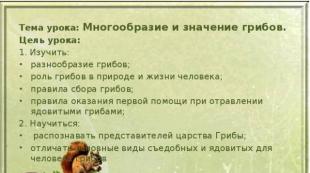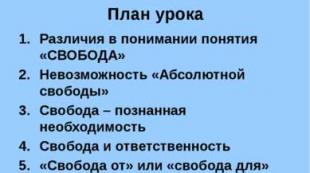Protective shutdown of electrical installations. Scope, basic requirements for RCDs, their types
What is a safety shutdown used for?
The danger of electric shock is determined by the voltage of contact (£ / doya1, V) and then by the strength of the current that can pass through the human body (/ "A). As you know.
where /? A is the resistance of the human body, Ohm.
If the touch voltage at the moment a person touches the body or network phase exceeds the permissible value, then there is a real threat of electric shock and the degree of protection in this case can only be a break in the current circuit, disconnecting the corresponding section of the network. To accomplish this task, a safety shutdown is used.
A safety shutdown is a fast-acting protection that provides automatic shutdown electrical installations in case of danger of electric shock to a person.
Grounding and zeroing do not always guarantee the safety of people. Protective shutdown significantly faster zeroing disables the damaged section of the installation than more guaranteed protection of people from injury electric shock.
When is a safety switch used?
Protective shutdown is used only in electrical installations with voltages up to 1000 V as independent protection or simultaneously with grounding:
in mobile electrical installations with isolated generator neutral;
in stationary installations with isolated neutral for the protection of those working with hand power tools;
in stationary electrical installations with a dead-earthed neutral on separate high-power consumers remote from transformers, on which zeroing protection is ineffective;
where there is an increased risk of electric shock. The scope of application of residual current devices is practically unlimited. They can be used in networks of any purpose and with any neutral mode. However, they are most widely used up to 1000 V, especially where it is difficult to carry out effective grounding or zeroing, when there is a high probability of accidental contact with live parts (mobile electrical installations, hand-held power tools).
What are the requirements for a protective shutdown and what functions does it perform?
Protective shutdown can be used as the main type of protection or together with grounding and zeroing.
The following requirements are placed on the residual current device: self-control, reliability, high sensitivity and short turn-off time.
Protective shutdown, alone or in combination with other means of protection, performs the following functions:
protection in case of a short circuit to the ground or the equipment case;
protection against dangerous leakage currents;
transition protection higher voltage on the side of the lower;
automatic control of the circle of protective grounding and zeroing.
How is a safety shutdown performed?
The protective shutdown is carried out by very sensitive and fast protective emerging devices. Sensitivity and transient action greatly exceeds circuit breakers or other measures items.
In electrical circuits, protective shutdown devices use sensitive elements that respond to the appearance of current in the neutral wire, voltage on the case of damaged electrical equipment, etc.
Protective shutdown devices operate in 0.1-0.05 s, while zeroing takes 0.2 or more seconds. With such a short duration of the passage of current through the human body, a current of even 500-600 mA will be safe. Given that the resistance of the human body is 1000 ohms, then the current of the reduced value can flow through the human body only if its voltage is 500-650 V, and there cannot be such a voltage in electrical networks with a voltage of 380/220 V with a grounded neutral even in emergency mode in emergency situations.
Protective disconnection is also used in cases where the grounding device will cause significant difficulties (rocky soils) or will be impractical due to the moving front of the work.
Therefore, protective disconnecting devices are reliable protection of people from electric shock.
One of the safety measures in electrical installations is the use of low voltages of the order of 36.34.12 V or less: for local lighting lamps at machine tools; for portable lamps (12 V); power supplies for electric soldering irons, electric drills and other electric tools.
Safety shutdown- high-speed protection that provides automatic shutdown of the electrical installation in the event of a danger of electric shock in it.
Such a danger can arise when the phase is shorted to the case, the insulation resistance drops below a certain limit, and if a person touches directly live parts that are energized.
The main elements of residual current devices (RCDs) is a residual current device, an executive body - a circuit breaker.
Residual current device (PZO)- this is a set of individual elements that perceive the input value, react to its changes and give a signal to turn off the switch. These elements are:
1 - sensor - a device that perceives a change in a parameter and converts it into a corresponding signal;
2 - amplifier (in case of a weak signal);
3 - control circuits - to check the health of the circuit;
4 - auxiliary elements (signal lamps and measuring instruments).
Circuit breaker- serves to turn on and off circuits under load. It should turn off the circuit when a signal is received from the residual current device.
Basic requirements for a residual current device (RCD):
1 - high sensitivity;
2 - short shutdown time (0.05-0.2s)
3 - selectivity of action, i.e. when there is danger;
4 - have self-control serviceability;
5 - sufficient reliability
The scope of application is practically unlimited. RCDs are most widely used in networks with voltages up to 1000V.
There are types of RCDs that respond to:
1 - body potential;
2 - ground fault current;
5 - zero sequence current;
6 - operational current.
There are combined devices that respond not to one, but to several input values.
Consider an RCD circuit that reacts to the potential of the case relative to the ground (figure).
The electrical installation is powered by a 3-phase, 3-wire network with isolated neutral.
1 – magnetic release contacts;
2 - button "start";
3 - stop button;
4 – normally closed contacts (NCC) of voltage relay 6;
5 - magnetic starter coil (U slave \u003d U l);
6 - voltage relay;
7 - button for checking the operation of the circuit;
8 - fuses;
9 - electrical installation;
10 - protective grounding;
11 auxiliary earth;
Figure 12.7. Residual trip circuit responsive to case potential to ground
Consider 3 modes of operation:
1. Normal operation.
When the "start" button (2) is pressed, the starter coil (5) is supplied with linear voltage through the closed contacts of the "stop" button (3), and normally closed contacts (4), voltage relay (6). When current flows through the starter coil (5), a magnetic field arises in it, which attracts the core on which the contacts (1) are located. They close and the electrical installation (9) is energized, and the additional contact blocks the “start” button (2) and it can be released. When the stop button (3) is pressed, the power supply circuit of the starter coil (5) is broken, the magnetic field disappears and the core on which the contacts (1) are located under the action of its own weight (or spring) returns to its original position. The electrical installation is disconnected from the network.
2. Emergency operation(phase short circuit to the case and break of the protective earth circuit)
With the installation enabled and having emergency mode on the body of the unit (9) there is voltage relative to the auxiliary ground (11), which is supplied to the voltage relay (6) through the closed contacts of the button (7). When the voltage on the installation case (9) is equal to the “setpoint” voltage of the voltage relay (6), it operates and opens its normally closed contacts (4). The "setpoint" voltage of the voltage relay (6) is selected from the safety conditions. The electrical installation is disconnected from the network. When the electrical installation is turned on again, the cycle will repeat.
3. Checking the health of the circuit.
When the electrical installation is turned on, which is in normal mode, when the button (7) is pressed (normally closed contacts are opened connecting the grounded housing of the electrical installation (9) and the voltage relay (6) and phase voltage is applied to the voltage relay (6). The electrical installation must be disconnected from the network.
Safety shutdown- high-speed protection that provides automatic shutdown of the electrical installation in the event of a danger of electric shock in it.
Such a danger may arise, in particular, when a phase is shorted to the electrical equipment case; when the insulation resistance of the phases relative to the ground drops below a certain limit; the appearance of a higher voltage in the network; touching a person to a live part that is energized. In these cases, some electrical parameters change in the network: for example, the case voltage relative to earth, phase voltage relative to earth, zero sequence voltage, etc. can change. Any of these parameters, or rather, changing it to a certain limit, at which danger arises electric shock to a person, can serve as an impulse that causes the operation of a protective shutdown device, i.e. automatic shutdown of a dangerous section of the network.
Residual current devices(RCD) must ensure the shutdown of a faulty electrical installation for a time not exceeding 0.2 s.
The main parts of the RCD are a residual current device and a circuit breaker.
Residual current device- a set of individual elements that respond to a change in any parameter of the electrical network and give a signal to turn off the circuit breaker.
Circuit breaker- a device used to turn on and off circuits under load and in case of short circuits.
RCD types.
RCD responding to case voltage relative to earth , are intended to eliminate the danger of electric shock in the event of an increased voltage on a grounded or grounded housing.
RCDs responding to operational direct current , are designed to continuously monitor the insulation of the network, as well as to protect a person who has touched the current-carrying part from electric shock.
Consider a circuit that provides protection when voltage appears on the case relative to ground.
Rice. Residual shutdown circuit at voltage on
hull relative to the ground.
The scheme works as follows. When the button P is turned on, the power circuit of the winding of the MP magnetic starter is closed, which turns on the electrical installation with its contacts and self-locks along the circuit composed of normally closed contacts of the “stop” button C, protection relay RZ and auxiliary contacts.
When a voltage appears relative to the ground on the case U z, equal in magnitude to the long-term permissible contact voltage, under the action of the RZ (KRP) coil, the protection relay is activated. RZ contacts break the MP winding circuit, and the faulty electrical installation is disconnected from the network. The artificial circuit circuit, activated by the K button, serves to monitor the health of the shutdown circuit.
It is advisable to use protective shutdown in mobile electrical installations and when using hand-held power tools, since their operating conditions do not allow ensuring safety by grounding or other protective measures.
Protective shutdown - a type of protection against electric shock in electrical installations, which provides automatic shutdown of all phases of the emergency section of the network. The duration of disconnection of the damaged section of the network should be no more than 0.2 s.
Fields of application of protective shutdown: addition to protective grounding or zeroing in an electrified tool; addition to zeroing to turn off electrical equipment remote from the power source; measure of protection in mobile electrical installations with voltage up to 1000 V.
The essence of the protective shutdown is that damage to the electrical installation leads to changes in the network. For example, when a phase is shorted to earth, the phase voltage changes relative to the earth - the value of the phase voltage will tend to the value of the linear voltage. This creates a voltage between the neutral source and the ground, the so-called zero-sequence voltage. The total resistance of the network relative to the ground decreases when the insulation resistance changes in the direction of its decrease, etc.
The principle of constructing protective shutdown schemes is that the listed regime changes in the network are perceived by the sensitive element (sensor) of the automatic device as signal input values. The sensor acts as a current or voltage relay. At a certain value of the input value, the protective shutdown is activated and switches off the electrical installation. The value of the input variable is called the setpoint.
The block diagram of the residual current device (RCD) is shown in fig.
Rice. Structural diagram of the residual current device: D - sensor; P - converter; KPAS - emergency signal transmission channel; IO - executive body; MOP - a source of danger of defeat
The sensor D responds to a change in the input value B, amplifies it to the value KB (K is the transfer coefficient of the sensor) and sends it to the converter P.
The converter is used to convert the amplified input value into a KVA alarm. Further, the channel for transmitting the emergency signal of the KPAS transmits the AC signal from the converter to the executive body (EO). The executive body performs a protective function to eliminate the danger of damage - it turns off the electrical network.
The diagram shows areas of possible interference that affect the operation of the RCD.
On fig. a schematic diagram of a protective shutdown using an overcurrent relay is given.

Rice. Residual current device diagram: 1 - maximum current relay; 2 - current transformer; 3 - ground wire; 4 - ground electrode; 5 - electric motor; 6 - starter contacts; 7 - block contact; 8 - starter core; 9 - working coil; 10 - testing button; 11 - auxiliary resistance; 12 and 13 - stop and turn buttons; 14 - starter
The coil of this relay with normally closed contacts is connected through a current transformer or directly into the cut of the conductor going to a separate auxiliary or common ground electrode.
The electric motor is switched on by pressing the "Start" button. In this case, voltage is applied to the coil, the starter core is retracted, the contacts close and the electric motor is connected to the network. At the same time, the auxiliary contact is closed, as a result of which the coil remains energized.
When one of the phases is shorted to the case, a current circuit is formed: the place of damage - the case - the ground wire - the current transformer - the earth - the capacitance and insulation resistance of the wires of undamaged phases - the power source - the place of damage. If the current value reaches the current relay operation setting, the relay will operate (i.e., its normally closed contact will open) and break the magnetic starter coil circuit. The core of this coil will be released and the starter will turn off.
To check the serviceability and reliability of the protective shutdown, a button is provided, when pressed, the device is triggered. The auxiliary resistance limits the earth fault current to the required value. Buttons are provided to enable and disable the starter.
The system of public catering enterprises includes a large complex of mobile (inventory) buildings made of metal or metal frame for street trade and service (snack bars, cafes, etc.). As a technical means of protection against electrical injuries and from a possible fire in electrical installations, the mandatory use of a residual current device at these facilities is prescribed in accordance with the requirements of GOST R50669-94 and GOST R50571.3-94.
Glavgosenergonadzor recommends using for this purpose an electromechanical device of the ASTRO-UZO type, the principle of which is based on the effect of possible leakage currents on a magnetoelectric latch, the winding of which is connected to the secondary winding of a leakage current transformer, with a core made of special material. The core in the normal mode of operation of the electrical network keeps the release mechanism in the on state. In the event of any malfunction in the secondary winding of the leakage current transformer, an EMF is induced, the core is retracted, and the magnetoelectric latch is activated, which is associated with the mechanism of free decoupling of contacts (the knife switch is turned off).
ASTRO-UZO has a Russian certificate of conformity. The device is included in the State Register.
A residual current device should be equipped not only with the above structures, but also with all premises with an increased or special risk of electric shock, including saunas, showers, electrically heated greenhouses, etc.
Protective automatic power off from the network (hereinafter referred to as the power supply) is carried out by automatically opening the circuit of one or more phase conductors (and, if necessary, the neutral working conductor), performed in order to protect against electric shock. This method of protection is implemented, for example, in the considered protective earthing system, as well as in the neutralizing system and in residual current devices. The characteristics of the protective devices of automatic shutdown and the parameters of the conductors must be coordinated in order to ensure the normalized time for disconnecting the damaged circuit by the protective switching device specified in the PUE, in accordance with the rated voltage of the supply network. Protective switching devices can respond to short-circuit currents (for example, in the zeroing system) or to differential current (residual current devices). In electrical installations where automatic power off is applied, potential equalization is performed in order to reduce the contact voltage in the period of time from the moment the emergency occurs until the power is turned off.
Zeroing It is used in electrical installations with voltage up to 1 kV and is a deliberate connection of open conductive parts of electrical installations (including their cases) with a solidly grounded neutral of a generator or transformer.
This connection is made by means of a neutral protective conductor (PE conductor). According to the instructions of chapter 1.7. PUE, such a system is designated TN (T - "terra" (English) - the neutral of the source is deafly grounded, N - "neutral" - open conductive parts are connected to this neutral). The zero PE conductor (“protection earth”) should be distinguished from the zero working conductor (N), which is also connected to a dead-earthed source neutral, but is intended to power single-phase power receivers. The PE and N conductors can be separated along their entire length, forming together with the phase five-wire system, designated TN-S (S - “separated” - “separated”). If they are combined in one PEN conductor throughout, then this is a four-wire TN-C system (C - “combination” - “combined”). An intermediate TN-C-S system is also used, in which, starting from the power source, a PEN conductor is laid, and then it is divided into separate N and PE conductors in the area of locating power receivers intended for connection to the TN-S system. From a safety point of view, the TN-S system is preferable to the TN-C system, since in normal operation the operating current does not flow through the PE conductor. Therefore, the potentials of the zeroed open conductive parts of electrical installations are practically the same and equal to the ground potential. The TN-S system, first proposed since the 70s of the XX century, has been widely introduced in domestic industry and in everyday life since 1995, however, the scope of the TN-C system (used since 1910) still prevails.
Installation and operation of three-phase networks is impossible without a clear (at a distance) identification of phase and neutral conductors. This is possible with the help of color coding. Buses of phase A (indicated in the diagrams L1), B (L2), and C (L2) are painted respectively in yellow green and red colors. Designations A, B, C - a direct sequence of letters of the Latin alphabet; a direct sequence of letters of the Russian alphabet, respectively - Zh, Z, K (the letter I is omitted). The working neutral conductor (N) is painted in blue color, protective (PE) – in yellow-green color (since the conductor is indicated by two letters, then there are two colors). The combined PEN-conductor is painted blue with transverse (oblique) alternating stripes of yellow and green applied at regular intervals. If using a network direct current, then the "+" bus is painted in to red color, "-" - in blue , zero (neutral) conductor - in blue . In electrical installations, the bus closest to a person (for example, when opening the power assembly door or when climbing an overhead line support) should always be a PE bus. This is followed by the N bus, and then the phase bus, and immediately after the N bus is the bus of phase C (red is the color of danger), then - B and, finally, the most distant bus is the bus of phase A. In DC networks, the bus closest to the person should be neutral, followed by the "+" bus (red), and then the "-" bus.
Having familiarized ourselves with the color marking of conductors, we will consider the principle of zeroing in a three-phase network using the TN-C system as an example (Figure 5.26).
Figure 5.26 - Protective grounding scheme (TN-C system)
Zeroing turns the breakdown of the phase to the case into a short circuit (short circuit) between the phase and zero protective conductors and contributes to the flow of current I to (Figure 5.26) of a large value. This current value ensures the operation of the protection device (A3), which automatically disconnects the damaged installation from the network. Such protection may be fuses or circuit breakers. The short-circuit current must be of such magnitude as to cause the fuse link to burn out or the circuit breaker to operate within a time not exceeding the allowable one.
According to the PUE, the maximum allowable time for a protective automatic shutdown in the TN system is 0.8; 0.4; 0.2 and 0.1 s depending on the rated phase voltage of the network: 127, 220, 380 and more than 380 V, respectively. The smallest areas are also regulated cross section zero protective conductors. If the protective conductors are made of the same material as the phase conductors, then their smallest cross section depends on the cross section of the phase conductors as follows:
If the cross section of the phase conductors is less than or equal to 16 mm 2, then the smallest cross section of the protective conductors is equal to the cross section of the phase conductors;
If the cross section of the phase conductors is greater than 16 mm 2, but less than 35 mm 2, then the cross section of the protective conductors must be at least 16 mm 2;
If the cross section of the phase conductors is more than 35 mm 2, then the cross section of the protective conductors is equal to half the cross section of the phase conductors, subject to the protection response time (0.4 s at a phase voltage of 220 V).
The cross sections of zero protective conductors made of other materials must be equivalent in conductivity to those given.
The zero protective conductor must not contain fuses and other disconnecting devices. It is permissible to use switches that disconnect both the neutral and phase wires at the same time.
Single-phase short circuit current I to flows through loop "phase-zero" (Figure 5.26). It consists of a phase conductor (the section from the power transformer to the damaged section), the metal case of the electrical installation connected to the PEN conductor, the PEN conductor itself (the section from the electrical installation case to the zero point of the power transformer), as well as the phase winding of the power transformer (in this case - phase windings A). If the resistance of the "phase-zero" loop is large, the protection operation time will exceed the maximum allowable time of the protective automatic shutdown. Therefore, the resistance of this loop is measured at least once every three years using M417, ESO202 and similar devices. With an unacceptable resistance value, an audit of the connections of the metal cases of electrical installations with a neutral conductor is carried out (the tightening of the bolted and the integrity of the welded contact joints are checked, scale is removed, and the contacts are cleaned from rust). After the revision, the contact resistance of the contacts is checked - it should be no more than 0.05 Ohm.
The zero protective conductor is connected to the ground by means of neutral grounding and repeated grounding conductors, the current spreading resistance of which is indicated respectively r 0 and r p (Figure 5.26). Re-grounding is performed at the ends of overhead lines (or branches from them longer than 200 m), as well as at three-phase (single-phase) inputs to buildings where there are electrical installations to be grounded. The neutral grounding resistance, the total resistance of the repeated grounding conductors and each of them individually should not exceed the established minimum values, for example, in a 380/220 V network, respectively, 4, 10 and 30 ohms (table 5.8). Zeroed parts of electrical installations are grounded through a neutral protective conductor. Therefore, during the emergency period (until the damaged installation is automatically disconnected from the network), protective action this grounding, i.e., the voltage of the zeroed parts relative to the ground decreases. Moreover, this is especially significant in the event of a break in the PEN conductor and short circuits of the phase to the case behind the break. In addition, due to the grounding of the source neutral, even in the absence of re-grounding, the potential on electrical equipment cases with damaged insulation is significantly reduced. On the overhead lines re-grounding of the neutral wire is also used for lightning protection purposes. As zero protective conductors, steel strips, metal braids of cables, metal structures of buildings, crane runways, etc. can be used.
In cases where electrical safety cannot be ensured in the TN system using protective grounding, in a network up to 1 kV with a solidly grounded neutral, grounding of open conductive parts using a ground electrode is allowed, electrically independent of the solidly grounded neutral source (TT system). At the same time, for protection in case of indirect contact, automatic power off is provided with the mandatory use of RCDs and compliance with the condition:
where I z is the operating current of the protective device; Rz - the total resistance of the grounding conductor and the grounding conductor of the electrical receiver most distant from the RCD. In addition, a potential equalization system is being implemented.
Safety shutdown- This is a high-speed protection system that automatically (in 0.2 s or less) turns off the electrical installation when there is a danger of electric shock to a person in it. Protective shutdown is used in cases where it is impossible or difficult to carry out protective grounding or zeroing, or when there is a high probability of people touching uninsulated live parts of electrical installations. Therefore, it is advisable to use protective shutdown to provide protection when using hand-held power tools, mobile electrical installations, as well as in everyday life.
When a phase is closed to the case, when the insulation resistance of the phases relative to the ground drops below a certain limit, when a person touches a live part that is energized, the electrical parameters of the network change, which can serve as an impulse for operation residual current devices (RCD), the main parts of which are a residual current device and a circuit breaker.
The residual current device responds to changes in the parameters of the electrical network and sends a signal to operate the circuit breaker, which disconnects the protected electrical installation from the network.
Residual current devices designed not only to protect a person from electric shock when touching open wiring or to electrical equipment that is energized, but also to prevent fire arising from the prolonged flow of leakage currents and short-circuit currents developing from them.
Thus, the main purpose of U3O: protection against leakage currents; protection against earth fault currents; fire protection.
Depending on the input signal, RCDs are known that respond to the housing voltage relative to earth, to the earth fault current, to the zero sequence voltage, to the differential current, to the operational current, etc.
A residual current device that reacts to the voltage of the case relative to earth (Figure 5.27) eliminates the risk of electric shock if an increased voltage occurs on a grounded or grounded case, for example, in the event of insulation damage.

Figure 5.27 - circuit diagram RCD that responds to the voltage of the case relative to the ground
The principle of operation is a quick disconnection from the network of the installation, if the voltage on the case relative to the ground is higher than the specified value, at which touching the case becomes dangerous. Such an RCD reacts not only to a complete breakdown of the insulation, but also to a partial decrease in its resistance.
The residual current device, operating on direct operational current, is designed for continuous automatic monitoring of phase insulation relative to earth, as well as for protecting a person who has touched current-carrying wires (Figure 5.28). In these devices, the active insulation resistance of three-phase wires r relative to the ground is estimated by the operating current I op received from an external source, passing through these resistances. When r decreases below the set limit, as a result of damage to the insulation and short circuit of the wire to the ground through a low resistance r zm or a person touching the phase wire, the current I op increases, causing the protected network to be disconnected from the power source.
A residual current device that responds to differential current provides protection in the event that a person touches a grounded or grounded body of an electrical installation when a phase is shorted to it, as well as when a person comes into contact with a live part that is energized. RCD of this type found wide application in the agro-industrial complex and in everyday life.

Figure 5.28 - Schematic diagram of an RCD operating on direct operating current (initial state)
A schematic diagram of such a residual current device is shown in Figure 5.29. The sensor is a current transformer (CT) (Figure 5.30).

Figure 5.29 - Schematic diagram of an RCD that responds to differential current (initial state)

Figure 5.30 - Ring-shaped magnetic circuit with the secondary winding of the transformer
If the currents in the phase wires I 1 , I 2 , I 3 are equal and shifted in phase by 120 ° relative to each other, then the total magnetic flux created by them in the TT magnetic circuit is equal to zero. When there is an asymmetry in the conductivities of the phases relative to the ground, for example, as a result of a phase-to-ground short circuit or a person touching a phase in the protection zone, then the equality of currents in the phases is violated. A differential current appears, equal to the vector sum of these currents, which, in accordance with the transformation ratio, is transferred to the secondary winding of the transformer at the input of the current relay winding (RT). If this current reaches (or exceeds) the value of the relay actuation current, then its normally closed contacts will open, disconnecting the electrical receiver from the mains. The relay will turn off even if the operator holds the control handle in the cocked position. If it is necessary to amplify the signal from the CT, a current amplifier is placed between it and the RT relay (not shown in Figure 5.29).
This type of residual current device can be used both in an isolated network and in a network with an earthed neutral. However, this disconnecting device is most effective in a network with a grounded neutral, in which the CT can also be put on the conductor that grounds the neutral point of the power transformer, as a result of which the entire network fed from it will be protected.
When protecting a single-phase power receiver, phase and zero working conductors are passed through an annular magnetic circuit, with the help of which it is connected to the mains. In normal operation, the currents in these conductors are equal and oppositely directed, so their total magnetic flux in the magnetic circuit is zero. In the event of a leakage to earth, the equality of currents is violated and a differential current appears. The subsequent operation of the RCD until the power receiver is disconnected from the network is similar to the device described above in relation to three-phase protection objects.
Residual current devices can serve as additional protection to grounding and grounding, as well as independent protection (instead of them) and do not depend on the grounding resistance and the resistance of the neutral conductor when grounding. The disadvantage of RCDs of this type is insensitivity to a symmetrical decrease in the phase insulation resistance in the protected electrical equipment, which occurs very rarely.
The following classification of residual current devices is known: AC - reacting to alternating sinusoidal current; A - responding to alternating, as well as pulsating direct current; B - reacting to alternating, direct and rectified currents; S - selective (with delay time off); O - the same as type S, but with a shorter turn-off time delay.
The presence of RCDs of type A and B is due to the fact that differential leakage currents can become pulsating or take on the form of a smoothed direct current due to the use of electronic devices, such as rectifiers or frequency converters. Residual current devices of type S and G are designed to provide selective shutdown of protected objects. So, with a multi-stage protection scheme, an RCD located closer to the power source should have a trip time of at least three times longer than the trip time of an RCD located closer to the consumer.
Residual current devices are produced with rated leakage currents of 10, 30, 100, 300, 500, 1000 mA. Moreover, RCDs with settings of 100 mA or more are usually used to ensure selectivity of protection, and with a setting of 300 mA, they are also used to protect against fire in case of a ground fault.
Residual current devices are electromechanical and electronic. The former do not depend on the supply voltage, since the energy of the input signal (differential current) is sufficient for their operation. The latter depend, as they are powered from a controlled network or from an external source (a low-power signal from a differential transformer is fed to an electronic amplifier, which supplies a powerful impulse to the release mechanism of the main contacts of the RCD - tens and even hundreds of watts, sufficient to operate a simple release). From this point of view, electronic RCDs are less reliable than electromechanical ones. In addition, if the neutral wire breaks to the installation site of the electronic RCD, it will not work without power, and the phase wire in the protected object will present a danger of electric shock. To eliminate this drawback, electronic RCDs are equipped with an electromagnetic relay operating in hold mode, which protects the object being switched off when the power supply of the protection device fails. A number of domestic enterprises produce electronic residual current devices, while in Germany, France, Austria and some other European countries it is allowed to use only RCDs that do not depend on the supply voltage. Electromechanical RCDs are produced by leading Western companies - Siemens, ABB, GF POWER, Legrand, Merlin Gerin, etc. Domestic electromechanical devices are known - ASTRO-RCD, DEC, IEC.
Combined RCDs are also known, equipped with an additional built-in protection against short-circuit currents and overloads - the so-called differential circuit breakers.
When choosing an RCD, it is necessary to be guided by the condition that the total leakage current of stationary and portable electrical receivers should not exceed 1/3 of the rated tripping current of the RCD. In the absence of data, the leakage current of electrical receivers should be taken at the rate of 0.4 mA per ampere of load current, and the leakage current of the network - at the rate of 10 μA per 1 m of the length of the phase conductor. Based on the latter condition, in old houses and industrial buildings with worn out wiring, an RCD with a rated tripping current of 30, not 10 mA, is installed. In new houses, in newly built industrial premises, as well as in sanitary facilities with high humidity to protect humans and animals from electric shock, an RCD with a rated tripping current of 10 mA is used (the leakage current of the network will not cause false positives).
The residual current device is connected in series with the circuit breaker, while the rated current of the circuit breaker is recommended to be selected one step lower than the rated current of the RCD. When connecting, it is recommended to use special cable lugs to prevent overheating at the point of contact.
For normal functioning The RCD must be checked monthly for its performance by pressing the "Test" button. Disabling the RCD indicates that the device is working properly. In livestock complexes and industrial premises, a performance check is carried out at least once a quarter.
RCD is not applied if the protected network feeds automatic systems fire extinguishing, ventilation, emergency lighting, as well as consumers first power supply reliability groups .
Electric receivers of the first group (categories)- electrical receivers, the interruption of the power supply of which can lead to a danger to people's lives, a threat to the security of the state, significant material damage, a disorder of a complex technological process, disruption of the functioning of especially important elements of public utilities, communication and television facilities. These power receivers are supplied with electricity from two independent mutually redundant power sources (the second can be a local diesel power plant), and a power outage can only be allowed for the period of automatic power restoration. In agro-industrial production, the first category electrical receivers are poultry factories.
RCD is allowed to be used to protect electrical receivers of the second and third categories of power supply reliability. Electrical receivers of the second category - electrical receivers, the interruption of power supply of which leads to massive undersupply of products, massive downtime of workers, mechanisms and industrial transport, disruption of the normal activities of a significant number of urban and rural residents. Electric receivers of the second category are provided with electricity from two independent mutually redundant power sources. In the event of a power failure from one of the power sources, power supply interruptions are permissible for the time required to turn on the backup power by the actions of the duty personnel or the mobile operational team. In agricultural production, power receivers of the second category are livestock complexes and greenhouses.
For electrical receivers of the third category power supply can be carried out from one power source, provided that power supply interruptions necessary for repairs do not exceed 1 day. Power receivers receive power from a single source. All residential buildings, garages, repair shops, etc. belong to power receivers of the third category of power supply reliability.
When choosing differential circuit breakers (automatic machines) it is necessary to remember that their main purposes are: protection against overload currents; protection against short circuit currents; leakage current protection; surge protection; fire protection.
Differential circuit breakers can be used in a wide range of ambient temperatures, allow connection of both copper and aluminum conductors, do not require maintenance during operation. Differential switches conform modern requirements fire safety, their body parts are made of materials that can withstand fire resistance tests at temperatures up to 960 ° C. Differential machines are available in two and four-pole versions. The device is mounted on a 35 mm DIN rail.
Just like with an RCD, the performance is checked by pressing the "Test" button - when it is pressed, the device instantly turns off. To turn on the device after this check, you must press the "Return" button and cock the switch handle.









